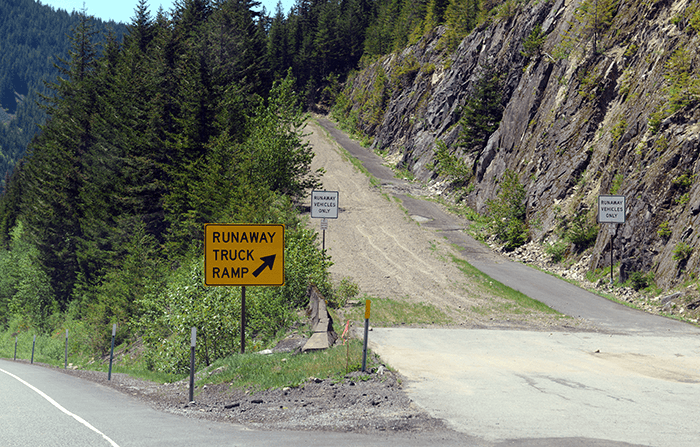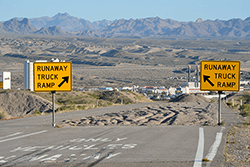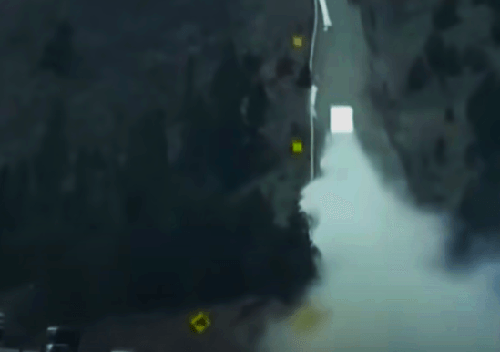When driving down a steep hill, you may have noticed the long off ramps to nowhere on the side of the highway. The ramps you are seeing are called truck escape ramps and they could be the only factor that prevents a horrendous emergency for heavy duty vehicles.

How Do I Use a Truck Escape Ramp?
1. Remain Calm
Hopefully you are not attempting to read this article while currently flying downhill without any brakes, but the first step (if this happens to you) is to remain calm. Easier said than done I’m sure, but the reasoning behind maintaining your composure is to prevent further injury to the drivers around you. Your first instinct may be to jerk the wheel to the side of the road as fast as you can which could cause your rig to jackknife or flip over on its side. Again, remain calm and assess the situation.
2. Engage the Jake Brake
The next step is to engage your jake brake so the truck can slow itself down while you are unable to use the service brakes. This will help prevent uncontrollable speeds and will also make it somewhat manageable to move around slower traffic if needed. Giving you precious seconds to safely locate your truck escape ramp
3. Notify Dispatch of your location
Next, if you can do it safely, notify dispatch of your current emergency scenario. This way, dispatch can provide emergency services time to get to your location in the event that anyone gets injured from your runaway truck.
4. Locate the Escape Ramp and Center your vehicle
Locate the truck escape ramp and center your truck as best as you can. Once you hit the sand or gravel incline, you will need to keep the wheel as steady as possible due to the massive stopping power that is about to occur.
5. Once Vehicle has Stopped, Assess Your Situation
Are you hauling flammable materials? Are you still in immediate danger? Do you have any injuries? Assess your situation by making sure you are ok before moving. Scenarios such as this can be frightening and could put some drivers in shock. If you feel you are injured, remain still and wait for emergency services to arrive as long as you are in no immediate danger of fire from your vehicle.
6. Turn off your engine, Seek Safety
Once you have notified dispatch or emergency services, remember to turn off your truck if it is still running. Gather the necessary paperwork from your cab and if you are not injured, safely exit your vehicle and wait for emergency services in a safe location.
What are Truck Escape Ramps?

Semi-truck drivers traverse all sorts of terrain. Whether it’s the extreme cold and frozen roadways of Alaska, or the treacherous inclines of Colorado, professional drivers are placed in dangerous situations on a daily basis.
Truck escape ramps are designated emergency locations that use sand, gravel, and/or wire nets to slow a heavy-duty vehicle quickly in the event of brake failure. Most of these ramps look like an exit ramp off the highway into a dead end. Some versions use gravity by quickly forcing the vehicle up a steep incline to combat the downward force. Truck escape ramps are mainly placed in steep decline areas where the brakes will be used on a constant basis.
Now you may be asking yourself, “Why would cities put these ramps on the highway if brake failure isn’t a common occurrence?” that’s because nearly 29% of collisions are caused by brake failure.
29%?! That seems high. With so many trucks out on the road, it’s not uncommon for routine maintenance to take a backseat to other important items. It should also be noted that this same study found 89% of all crashes were due to driver negligence. This sort of statistic is why the FMCSA is constantly focused on driver safety and good driving habits.
This is also why its important to have a roadside assistance membership for your fleet. When you forget to properly maintain your vehicle and it does indeed have a breakdown, you will be protected from the labor costs during replacement or repair.
Why Do Brakes Fail?
While driving in steep declines, truckers have a process they must be aware of in the event of brake failure. Big rigs are holding some serious weight on those wheels, and if you are familiar with kinetic energy, you will realize the stopping power required for these trucks is an extremely high number (add a large downhill road to the mix and a dangerous outcome could be imminent).
Some inexperienced drivers think that no matter how fast a vehicle is travelling, the brakes will always work and they will be able to stop. What these drivers fail to know (or are improperly trained to realize) is that a braking system can only do so much when hauling massive amounts of weight down a hill. You cannot simply press the brake the whole time you are moving downwards. This will lead to the brakes overheating and becoming worthless during the worst part of your descent.
Below is a list of most common reasons behind brake failure.
- Poorly adjusted brakes
- Overheating
- Worn or old brake components
- Incorrect air pressure
Notice that most of the common reasons for brake failure can be prevented with routine maintenance. Proper pre-trip inspections mixed with a preventative maintenance plan could save you thousands in insurance deductibles, lawsuits, and fees.
The Importance of the Jake Brake
Experienced drivers will tell you that the jake brake is your best friend during extreme decline roadways. In simplest terms, when operating the jake brake, you are using the engine to slow the vehicle down. You can find a very extensive article on proper jake brake usage at smart-trucking.com.
The most common method veteran drivers use is to switch the jake brake to the on position and use it while travelling down to the bottom of the hill. Doing this while also applying the service brake as a support structure will help prevent the engine from overheating and increase the overall lifespan of your service brake. It will also prevent the catastrophe of brake failure and the need to use the runaway truck ramp.
Why is it important to know this information?
You may be thinking you don’t traverse steep grades very often on your route, therefore you don’t necessarily need this information. You may be right, unlike some locations (Backbone Mountain in Maryland for example) where fatalities are way too common, this information is a need by need basis. However, you should always prepare for the worst while expecting the best. Your life and the life of other drivers may be at stake.


Comments are closed